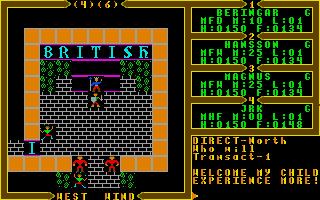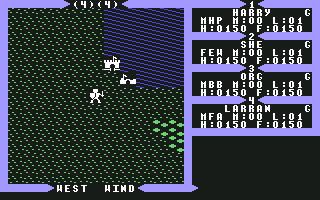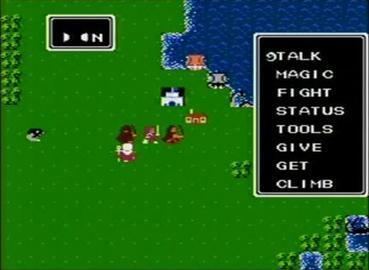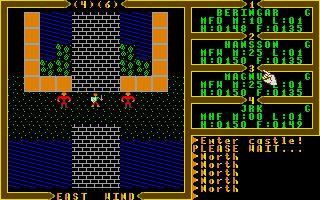8 /10 1 Votes
3.5/5 GamesNostalgia Mode(s) Single player | 4.4/5 My Abandonware Initial release date 1983 | |||||||||||||||||||||||||||||||||
 | ||||||||||||||||||||||||||||||||||
Composer(s) Ken Arnold (home computers)Gotō Tsugutoshi (NES) Genre(s) Role-playing video game Publishers Origin Systems, Electronic Arts, Pony Canyon, Fujisankei Communications International, Star Craft, Inc. Similar Ultima games, Origin Systems games, Role-playing video games | ||||||||||||||||||||||||||||||||||
Ultima iii exodus pc video game years 1983
Ultima III: Exodus is the third game in the Ultima series. Exodus is also the name of the game's principal antagonist. Released in 1983, it was the first Ultima game published by Origin Systems. Originally developed for the Apple II, Exodus was eventually ported to 13 other platforms, including a NES/Famicom remake.
Contents
- Ultima iii exodus pc video game years 1983
- Ultima iii exodus nes speed run 0 43 37 by presjpolk
- Gameplay
- Plot
- Development
- Reception and legacy
- References

Ultima iii exodus nes speed run 0 43 37 by presjpolk
Gameplay

Exodus featured revolutionary graphics for its time, as one of the first computer RPGs to display animated characters. Also, Exodus differs from previous games in that players now direct the actions of a party of four characters rather than just one. During regular play the characters are represented as a single player icon and move as one. However, in battle mode, each character is represented separately on a separate "battle screen" and the player alternates commands between each character in order, followed by each enemy character having a turn. Thus the player must understand weapons and magic commands and employ rudimentary tactics in order to overcome each opponent. This differs from the two previous games in the Ultima series in which the player is simply depicted as trading blows with one opponent on the main map until either is defeated. Enemies on the overworld map can be seen and at least temporarily avoided, while enemies in a dungeon may appear randomly without any forewarning.

The party of four that a player uses can be chosen at the beginning of the game. There is a choice between 11 classes as follows: Fighter, Paladin, Cleric, Wizard, Ranger, Thief, Barbarian, Lark, Illusionist, Druid, and Alchemist. Each class has a specified race among five different races. The default race for each class is the recommended race, but this can be edited along with attribute points for each character for Strength, Dexterity, Intelligence and Wisdom. The races determine limitations on maximum stat growth (i.e., some races allow certain stats to be maxed out while others limit the stats to half the maximum amount.) Certain spells will be unavailable for certain races that are limited in their maximum allowed Wisdom and Intelligence stats, thus a wise player will investigate the best races for their mages before commencing the game.

For the most part, all the classes of characters are built around four main classes with very minor differences. These are Fighter, Cleric, Wizard, and Thief. Fighter type classes are strong in melee and in defense, but with the exception of the Ranger, have no spells or abilities, and can equip most armor and weapons. The Thief type classes are good at resisting traps that may be in dungeons or in chests and are limited in what weapons and armor they can equip. Cleric type classes have healing spells and spells strong against undead enemies and are limited to cloth/leather armor and staffs/maces. Wizard type classes have strong offensive type spells and are limited to cloth armor and staffs.

Each character begins at Level 1 and increases individually. As the game progresses and enemies are defeated, characters increase their levels according to the experience points gained. More challenging enemies (such as dragons or sea monsters) earn higher experience points than easier enemies (e.g., orcs, goblins, or skeletons). This is to let characters increase in levels relatively evenly, as bigger and stronger enemies appear as soon as one character surpasses a given level. One thing that is common is wizard and cleric types outleveling the melee types because they have area of effect attacks and ranged attacks that allow them to kill enemies well before the melee types can even get to the enemy. The maximum effective level for characters is 25. Beyond this point the level will continue to increase; however the number of Health Points is fixed at 2550. Maximum health points for a character can be calculated by the following formula: H.P.= 100 * L + 50 (where L is the current Level of the character). It is recommended, but not necessary, to level up characters to the maximum to have the best chance of defeating Exodus. When a character has gained enough experience points, they must talk (i.e., "Transact") with Lord British for the character to level up. Characters must gain the Mark of Kings to increase their Health Points beyond 550.
One of the key items in the game that a player must have is food. Characters must regularly buy food from a grocer. If a character's food runs out, he will start taking damage each turn, much like being poisoned. Food depletes rapidly while traveling on the outdoor map, but slowly or not at all in dungeons—however it can also be stolen by gremlins in dungeons. Using horses or ships for transport slows the rate of food depletion compared to walking.
Aside from the ability to talk to townspeople there are other commands that can be used on them. Some of the commands a player can use are bribe, steal, and fight. Bribing can be used to make certain guards go away from their post. Steal can be used on townspeople and some enemies, but can result in conflict with townspeople if caught. A player can choose to fight a townsperson, but it will prompt the guards to chase after your characters, which always come in parties of eight and are very difficult to defeat (and carry almost no treasure). You can also choose to fight Lord British, but he cannot be killed, thus resulting in a long, drawn-out fight that the player will ultimately lose. Lord British can be "temporarily" killed by cannon fire from a ship in the castle moat, but exiting and re-entering the castle restores him.
Unlike the two previous Ultima games, which had wire-frame first-person dungeons, Exodus dungeons are solid-3D in appearance and integrated into the game's plot. Dungeons are foreboding mazes that can take a long time to navigate but are necessary to obtain certain marks that are needed to finish the game. Each dungeon has 8 levels, and the deeper the level the more challenging the enemies. Note: the monsters that are spawned in dungeons are not based on your character level as the overworld monsters are; rather, they are based on the dungeon level you are exploring, so going too deep into certain dungeons may be too hard for characters in the early stages of the game. One can find many chests (with gold, weapons, and armor) inside dungeons, but many of them are trapped. Aside from chests and marks, one can find fountains in dungeons: some heal, some cure, and some poison. Peering at Gems allows you to see a map of a given dungeon level; torches or light-casting spells are necessary to be able to see inside dungeons. Most of the most valuable marks are found in the lowest dungeon levels.
There are three modes of travel in the game: on foot, horseback, and boat. Getting around on foot is slow and can often lead to monsters catching up to you. Horseback gives you the advantage of moving faster while consuming less food, making getting away from unwanted fights easier. Horses can only be bought from a few towns and are 800 gold pieces. Getting a boat can be tricky; it requires players to reach a certain level so that pirate ships begin appearing. Once a pirate ship is sighted, they will approach the characters to fight them. Upon their defeat, the boat belongs to the player. Obtaining a boat is necessary in order to visit the underworld ("Ambrosia"), and ultimately necessary to win the game.
By denying the player the ability to see what's behind mountain peaks, forests, and walls, the overland maps contain many small surprises such as hidden treasure, secret paths, and out-of-the-way informants. The look of the game is no longer based on certain characteristics of the Apple II hardware; it is rather a carefully designed screen layout.
Beating the game requires the player to get all four marks and all four prayer cards. Once you get to the altar of Exodus, you insert the cards in a particular order, and thus defeat Exodus.
Plot
After Ultima II: The Revenge of the Enchantress was set on Earth, the story of Exodus centers on a quest back in Sosaria, the world of Ultima. The player's mission is to destroy the final remnant of the evil Mondain and Minax. The game is named for its chief villain, Exodus, a creation of Minax and Mondain that the series later describes as neither human nor machine. Although a demonic figure appears on the cover of the game, Exodus turns out to something like a computer (possibly an artificial intelligence) and to defeat him the player has to acquire four magic (punch)cards and insert them into the mainframe in a specific order.
At the beginning of the game, Exodus is terrorizing the land of Sosaria from his stronghold on the Isle of Fire (known as Fire Island in Ultima Online). The player character is summoned by Lord British to defeat Exodus and embarks on a quest that takes him to the lost land of Ambrosia, to the depths of the dungeons of Sosaria to receive powerful magical branding marks and to find the mysterious Time Lord, and finally to the Isle of Fire itself to confront Exodus in his lair.
The game ends immediately upon Exodus' defeat; but unlike many games in the genre, Exodus cannot simply be killed in battle by a strong party of adventurers, but only through clever puzzle-solving and by paying attention to the many clues given throughout the game. At the end of the game, players were instructed to "REPORT THY VICTORY!" to Origin. Those who did so received a certificate of completion autographed by Richard Garriott.
Although this is the last game in the series to take place in Old Sosaria, places in the game such as Ambrosia and the Isle of Fire make cameo appearances in later games, namely Ultima VII.
Development
Ultima III was the first game in the series published by Richard Garriott's company Origin Systems. Ports appeared on many different systems.
*The publisher Starcraft has no relation to the video game StarCraft and went out of business in 1996.Reception and legacy
Over 120,000 copies of Ultima III were sold, and Video magazine listed the game seventh on its list of best selling video games in March 1985 with II Computing listing it fifth on the magazine's list of top Apple II games as of late 1985, based on sales and market-share data.
Exodus is credited as a game that laid the foundation for the role-playing video game genre, influencing games such as Dragon Quest and Final Fantasy. In turn, Exodus was itself influenced by Wizardry, which Richard Garriot credited as the inspiration behind the party-based combat in his game.
Softline stated that Ultima III "far surpasses" its predecessors, praising the "masterfully unified" plot and individual tactical combat. The magazine concluded that the game "upgrades the market; in several ways it sets new standards for the fantasy gaming state of the art. Happily, it also shows us a maturing artistic discipline on the part of its imaginative author". Computer Gaming World's Scorpia called Ultima III "unquestionably the best in the series so far ... many hours of enjoyment (and frustration!)", although she criticized the ending as anticlimactic. The magazine's Patricia Fitzgibbons later reviewed the Macintosh version. She complimented its graphics but criticized the audio, and stated that the game did not adequately use the computer's user interface, describing using the mouse as "aggravating". Fitzgibbons concluded "Even though the Mac conversion is far from ideal, Ultima III is a very enjoyable game, and well worth its hefty price". In 1993 Scorpia stated that Ultima III was the best of the first trilogy, and that its "surprisingly quiet and nonviolent" defeat of the villain presaged the later games' "resolutions that are less combative in spirit".
Compute! in 1984 stated that Ultima III "ushers in an exciting new era of fantasy role-playing. The combination of superb graphics, music, and excellent playability makes Exodus a modern-day masterpiece". It noted the cloth map and the extensive documentation, the "thrilling" 3-D dungeons, the game's use of time, and the spell system. The magazine concluded, "Lord British has outdone himself with his latest work of art ... a delight to play". INFO stated that "Lord British's latest offering is also his best ... Many wonderful hours will be spent unravelling its secrets". The Chicago Tribune called Ultima III "one of the best" computer games, providing "an epic adventure which can last for months". Famitsu reviewed the 1987 Famicom remake and scored it 32 out of 40.
In 1984 Softline readers named the game the third most-popular Apple and eighth most-popular Atari program of 1983. It won the Adventure Game of the Year prize in Computer Gaming World's 1985 reader poll, about which the editors wrote "Although Ultima III has been out well over a year, we feel that it is still the best game of its kind." With a score of 7.55 out of 10, in 1988 Ultima III was among the first members of the Computer Gaming World Hall of Fame, honoring those games rated highly over time by readers. In 1996, the magazine ranked it as the 144th best game of all time, featuring "one of the nastiest villains to grace a computer screen".
The demon figure that appeared on the front of the box caused some religious fundamentalists to protest. They made accusations that the game was corrupting the youth of America and encouraging Satan worshiping. This, along with other factors, led Richard Garriott to develop his next game (Ultima IV) based on the virtues the Ultima series became famous for.
